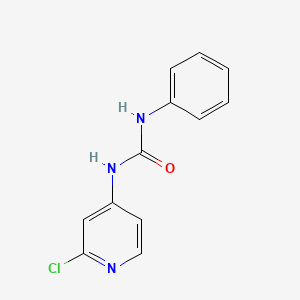D0947 | forchlorfenuron
| Toxicity | Dose | Time | Species | Model | Method | Action | Positive criterion | Reference |
|---|---|---|---|---|---|---|---|---|
| MEMBRANE POTENTIAL | 0.45±0.13 | human | qHTS-HepG2 | MMP assay | decrease | IC50 | 163 | |
| MEMBRANE POTENTIAL | 1 | human | HepG2 | MMP assay | decrease | IC50 | 163 | |
| MEMBRANE POTENTIAL | 2.19±1.97 | rat | hepatocytes | MMP assay | decrease | IC50 | 163 | |
| Pictogram | Signal | Statements | Precautionary Statement Codes |
|---|---|---|---|
  |
Warning |
H351: Suspected of causing cancer [Warning Carcinogenicity] H411: Toxic to aquatic life with long lasting effects [Hazardous to the aquatic environment, long-term hazard] |
P201, P202, P273, P281, P308+P313, P391, P405, and P501; (The corresponding statement to each P-code can be found at the GHS Classification page.) |
  |
Warning |
Aggregated GHS information provided by 199 companies from 2 notifications to the ECHA C&L Inventory. Each notification may be associated with multiple companies. H351 (100%): Suspected of causing cancer [Warning Carcinogenicity] H411 (100%): Toxic to aquatic life with long lasting effects [Hazardous to the aquatic environment, long-term hazard] Information may vary between notifications depending on impurities, additives, and other factors. The percentage value in parenthesis indicates the notified classification ratio from companies that provide hazard codes. Only hazard codes with percentage values above 10% are shown. |
P201, P202, P273, P281, P308+P313, P391, P405, and P501; (The corresponding statement to each P-code can be found at the GHS Classification page.) |
  |
Warning |
H351: Suspected of causing cancer [Warning Carcinogenicity] H411: Toxic to aquatic life with long lasting effects [Hazardous to the aquatic environment, long-term hazard] |
P201, P202, P273, P281, P308+P313, P391, P405, and P501; (The corresponding statement to each P-code can be found at the GHS Classification page.) |
   |
Warning |
H320: Causes eye irritation [Warning Serious eye damage/eye irritation] H335: May cause respiratory irritation [Warning Specific target organ toxicity, single exposure Respiratory tract irritation] H351: Suspected of causing cancer [Warning Carcinogenicity] H361: Suspected of damaging fertility or the unborn child [Warning Reproductive toxicity] H371: May cause damage to organs [Warning Specific target organ toxicity, single exposure] H401: Toxic to aquatic life [Hazardous to the aquatic environment, acute hazard] H411: Toxic to aquatic life with long lasting effects [Hazardous to the aquatic environment, long-term hazard] |
P201, P202, P260, P261, P264, P270, P271, P273, P281, P304+P340, P305+P351+P338, P308+P313, P309+P311, P312, P337+P313, P391, P403+P233, P405, and P501; (The corresponding statement to each P-code can be found at the GHS Classification page.) |
| Organism | Test type | Route | Dose (normalized dose) | Effect | Source |
|---|---|---|---|---|---|
| rat | LD50 | skin | > 10gm/kg (10000mg/kg) | Farm Chemicals Handbook. Vol. -, Pg. C22, 1991. | |
| rat | LD50 | oral | > 10gm/kg (10000mg/kg) | Farm Chemicals Handbook. Vol. -, Pg. C22, 1991. | |
| dog | LD50 | oral | > 5gm/kg (5000mg/kg) | "Pesticide Index," Frear, E.H., ed., State College, PA, College Science Pub., 1969Vol. 4, Pg. 81, 1969. | |
| 1-(2-Chloro-4-pyridyl)-3-phenylurea | 1-(2-chloranylpyridin-4-yl)-3-phenyl-urea | 1-(2-chloro-4-pyridinyl)-3-phenylurea |
| 1-(2-chloropyridin-4-yl)-3-phenylurea | 3-(2-chloropyridin-4-yl)-1-phenylurea | 4-CPPU |
| 4CH-018034 | 4PU30 cpd | 57F608 |
| 68157-60-8 | A836038 | AB0014042 |
| AC-11699 | ACMC-209o29 | AK-51740 |
| AKOS015895398 | ANW-35455 | AS-14155 |
| AX8131481 | BIC0279 | BR-51740 |
| C-15151 | C18604 | CAS-68157-60-8 |
| CC-28817 | CF-003 | CHEBI:81861 |
| CHEMBL1229826 | CM10941 | CPPU |
| CS-6276 | CTK3J6742 | DB-055112 |
| DSSTox_CID_14634 | DSSTox_GSID_34634 | DSSTox_RID_79182 |
| DTXSID1034634 | FT-0626521 | Forchlorfenuron |
| Forchlorfenuron (KT-30) | Forchlorfenuron (KT-30, CPPU) | Forchlorfenuron 10 microg/mL in Methanol |
| Forchlorfenuron [ANSI:ISO] | Forchlorfenuron [ISO] | Forchlorfenuron, 98% |
| Forchlorfenuron, PESTANAL(R), analytical standard | GPXLRLUVLMHHIK-UHFFFAOYSA-N | HSDB 7983 |
| HY-B1841 | K126 | K62IP7463J |
| KS-00000GBE | KSC496O4F | KT-30 |
| LS-159608 | LS41254 | M-1619 |
| MCULE-6325790412 | MFCD00059898 | N-(2-Chloro-4-pyridinyl)-N'-phenylurea # |
| N-(2-Chloro-4-pyridinyl)-N;-phenyl | N-(2-Chloro-4-pyridyl)-N'-phenylurea | N-(2-Chloro-4-pyridyl)-N'-phenylurea, applicable for cell culture, BioReagent; |
| N-(2-chloro(4-pyridyl))(phenylamino)carboxamide | N-(2-chloro-4-pyridyl)-N`-phenylurea | NCGC00164383-01 |
| NCGC00164383-02 | NCGC00164383-03 | NCGC00254994-01 |
| Q-201133 | Q408770 | RTR-022810 |
| SC-12211 | SCHEMBL119685 | ST2403101 |
| ST51039313 | TR-022810 | Tox21_301094 |
| UNII-K62IP7463J | Urea, N-(2-chloro-4-pyridinyl)-N'-phenyl- | ZINC402792 |
| ZX-AFC000639 | s5306 |

